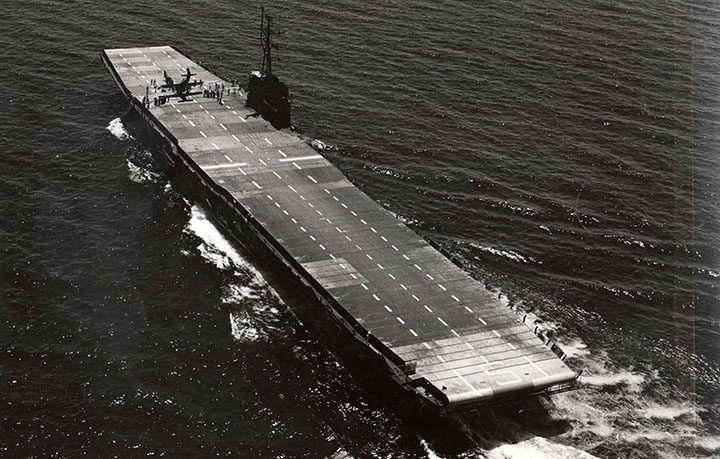When aircraft carriers sailed Lake Michigan

Courtesy Photos The U.S.S. Sable is seen on Lake Michigan.
CHICAGO — On Sunday morning, Dec. 7, 1941, Japanese aircraft attacked Hawaii’s Pearl Harbor.
Meanwhile, Germany widened invasions of European countries.
The following Dec. 8 and 11, Congress declared war on those nations, as well as Italy.
With that declaration, all of America’s ground, air, and sea forces and equipment were needed for the war fronts.
The Navy’s aircraft carriers needed to be on the front lines, ready for combat. The Navy’s immediate and foreseeable need was to train pilots and crews on how to take off and land on aircraft carriers.

The Seeandbee is converted to the U.S.S. Wolverine aircraft carrier in Buffalo, New York.
Early in 1942, Navy Commander Richard Whitehead proposed to the chief of naval operations: “Why not train pilots and crew on the Great Lakes?”
However, building new freshwater aircraft carriers would take time.
The approach was to find current Great Lakes ships that could be converted to training aircraft carriers. The modification process found two side-wheel Great Lakes passenger ships: the S.S. Greater Buffalo, with 650 state rooms, provided overnight passenger service between Buffalo and Detroit. The ship’s maiden voyage occurred in May 1925.
The other ship, the S.S. Seeandbee featured 510 state rooms serving up to 6,000 passengers. The ship’s name represented the initials of the company which owned the ship. The vessel went into service in June 1913.
Both of those multi-decked ships offered various passenger state room configurations, dining rooms, entertainment and dance rooms, and could carry automobiles and freight. Each had a massive propulsion and electrical generation system, as well as an onboard telephone service.

The Greater Buffalo entered Great Lakes sailing in May 1925.
The War Department acquired those ships. They both underwent conversion in Buffalo, New York under tight port and staff security. Reports indicated the conversions were conducted around the clock by a peak crew of 1,250, not reflective of significant U.S. Coast Guard port security.
The Seeandbee was purchased by the Navy for $756,500. The Navy’s acquisition price for the Greater Buffalo is unknown.
Both ships’ conversion process stripped away all passenger and crew components. The new configuration added officer and crew quarters, an infirmary, mess (dining) areas, training rooms, and related military needs. Each ship had 500-plus-foot wooden flight decks laid. World War II Navy aircraft carrier fleet offered flight decks of 800 to 850 feet.
The Greater Buffalo was commissioned by the Navy in May 1943 as the U.S.S. Sable. A portion of the ship’s crew were from the U.S.S. Lexington, which was lost in the Battle of the Coral Sea.
The Seeandbee was commissioned by the Navy in August 1942 as the U.S.S. Wolverine.
The converted ships were fondly known as the Navy’s Great Lakes “Corn Belt fleet” and stationed off Chicago’s Navy Pier shores. The Sable and Wolverine each had their own officers and enlisted crew, which numbered in the range of 300. In addition, the ships had staffing and training interaction with the nearby Great Lakes Naval Training Station and the Glenview Naval Air Station.
Published accounts by historian and author Terri Wangard offered the following profile of training and related aspects onboard these two ships:
“After flight training, pilots came to Glenview Naval Air Station west of Chicago for carrier qualifications. Day one took place in a classroom. Day two saw them practicing on ‘bounce fields’ where they had to land in small, designated areas. On day three, they had to land and take off on one of the ‘postage stamp sized’ carriers. After eight landings and take offs, they became carrier qualified.”
Wangard commented: “The carriers were dangerous. Arresting wires snapped, planes crashed and burned, deck crewmen would be hit by spinning props, even snow squalls in winter.”
She added: “Even calm days presented problems. If the carriers couldn’t generate sufficient ‘wind over deck,’ certain types of aircraft couldn’t take off. Instead of using the aircraft they would fly in combat, pilots had to use lightweight training aircraft.”
Wangard concluded: “These lake carriers were not true aircraft carriers. They lacked elevators, hanger decks, and armaments. If too many damaged aircraft cluttered the flight deck, flight operations had to be curtailed. Because the carriers were coal-fired, dense smoke might hang over the deck.”
During both carriers’ operation, eight personnel lost their lives and 130-plus aircraft were lost in Lake Michigan’s waters.
Both ships received U.S. Navy campaign and victory medals in recognition of their unique service,
After World War II concluded, both ships were decommissioned and sold as scrap. The Wolverine was sold for $46,789 to Milwaukee’s A. F. Wagner Iron Works. The Sable was sold to Canadian-based H.H. Buncher Co. The scrap acquisition cost is not known.
YouTube offers a number of videos on the Wolverine and Sable. That includes the full-length feature “Heroes on Deck: World War II on Lake Michigan.”
In addition, the Air Zoo Aerospace and Science Center in Kalamazoo has on display in the museum’s restoration bays Douglas Dauntless SBD-1 and FM-2 Wildcat aircraft recovered from Lake Michigan. Across the nation, other military museums also display Wolverine and Sable aircraft retrieved from Lake Michigan.
Together, the Wolverine and Sable trained 17,820 pilots. One of those was former President George H.W. Bush, who conducted flight training on the Sable.
Jeffery D. Brasie is a retired health care CEO. He frequently writes historic feature stories and op-eds for various Michigan newspapers. He is a U.S. Navy and U.S. Naval Reserve veteran and served on the public affairs staff of the secretary of the Navy. He grew up in Alpena and resides in suburban Detroit.
- Courtesy Photos The U.S.S. Sable is seen on Lake Michigan.
- The Seeandbee is converted to the U.S.S. Wolverine aircraft carrier in Buffalo, New York.
- The Greater Buffalo entered Great Lakes sailing in May 1925.





